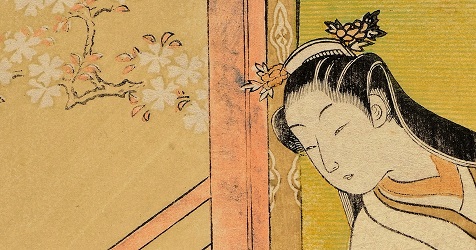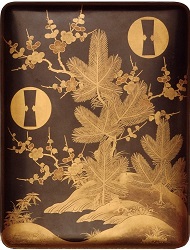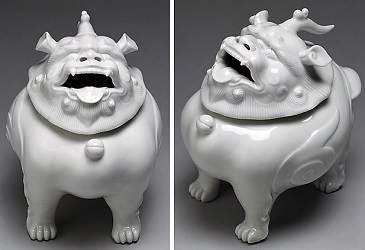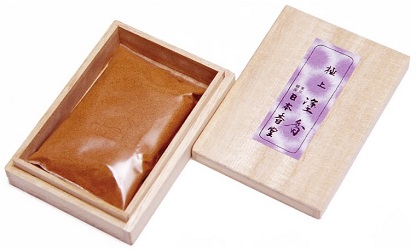
Along with glorious statues, ritual objects and religious texts and scholarship, incense arrived in Japan with Buddhism in the sixth century. Incense experienced in temples during Buddhist ceremonies must have inspired Japanese (who could afford it) to burn incense in their homes, not only to commemorate ancestors, deities and important life (and death) events, but to show they were sophisticated. Houses were scented, clothes were hung in ways and places to absorb incense aromas, hair was perfumed. Over the centuries lighthearted ways to enjoy incense were developed: the incense ceremony (kodo) and incense games (one of the most famous, Genji-ko, was associated with the eleventh-century novel The Tale of Genji).
Japanese incense blends changed over time, from complex mixes of ingredients formed into a variety of shapes to "purer" enjoyment of prized, rare, exorbitantly priced wood chips. Raw materials used for incense included shells, figwort, clove, benzoin, cinnamon, star anise, machilus (a member of the laurel family). The royalty of incense ingredients (enjoyed singly, too) were sandalwood and varieties of Aquilaria (known by a variety of names and quality grades: aloeswood, agarwood, kyara, oud). Whenever I'm in a museum with Asian collections, I always search out incense storage boxes...and burners; some of my favorites show dragons and lions, mouths agape, nostrils flared, so smoke will seep from between their lips and out their noses. Dramatic, yes, but because of their diminutive size, charming and endearing, too.

Zu-koh (incense powder), like powdered incense from India, was used in religious ceremonies to purify worshippers, officiants and the religious space itself. Powdered incense was considered "cleansing" (think antiseptic) and was used on the palms, head, and sprinkled on floors (a great practice for temples that required a 'no-footwear' policy). Some accounts said that the strictest monks would eat powdered incense for inside-out purification. Even today, if you visit certain temples in Japan you may be offered powdered incense as you enter.
You can certainly use today's review subjects in meditation or religious practice, but they're great as perfume alternatives, for days when you want something interesting, but subtle. Before the reviews, some notes: incense powders are brown colored because of spices (clove, cinnamon, etc.); I wouldn't recommend lavish use of these powders when you wear your favorite white shirt. Incense powders used in small quantity and rubbed into skin should pose no staining problem, but do think of using them in places where contact with textiles is minimal: ear lobes and the area on your neck right beneath your ears; wrists; and forearms (on short-sleeve or no-sleeve days). In warm weather when you're wearing shorts, put some incense powder on your legs and sandal-clad, or bare, feet. You can also, especially if you like clay/dry hair pomades that produce a matte finish, sprinkle a small amount of powdered incense on your comb or hair brush and scent your hair. What I'm saying is: use your incense powder; it doesn't last. I have boxes of incense from Japan that are 18 years old and still smell wonderful when I burn some; the powdered nature of zu-koh means the scent will not last so long (use your powder within a year and store it in an airtight container).
Finally, and most importantly, DO NOT put incense powder on your pets or their beds; some herbal ingredients are toxic. Store your powdered incense away from curious dogs and cats. And if you're thinking of making your own powdered incense by pulverizing some incense sticks or cones: don't. First, the formulas for body powder and incense you will ignite are different; some ingredients in incense sticks and cones you don't want on your skin.

Now to the incense powders! The powders I'm reviewing today are "mainstream," not niche (but are easy to find in the U.S.) If you want a truly esoteric incense powder blend, visit Japan or have a friend there (whose nose you trust) send you something "weirder" than today's "classic" offerings.
Shoyeido Tokusen Incense Body Powder, $30, contains clove, camphor, cinnamon, sandalwood, patchouli and spices. This blend is the "premium" quality zu-koh that Shoyeido sells which means it's heavier on the woods and lighter on the inexpensive spices like cinnamon and cloves. Tokusen smells of powdery sandalwood wrapped in benzoin, with glints of the C-sweet — clove-cinnamon-camphor. This is a sweet blend and smells like "good Japanese incense," the type you've smelled if you've visited Japanese markets or temples (where the expensive/strange herbal blends are kept for special occasions and a select few). I'd recommend this blend to start your exploration of incense powders. (Shoyeido offers two other powder blends: "Fine Quality" Johin, $10, and "Extra Fine Quality" Gokuhin, $17.50; think of these as "body spray" and "Eau de Cologne" versions of Tokusen.
Baieido Zukoh, $18, contains cinnamon, camphor, clove, star anise, cassia, sandalwood and herbs. If your tastes run more towards spicy fragrances with wood accents in the background, try Baieido Zukoh. This has an autumnal vibe for me because right now I'm smelling mulled wine and cider, spiced lattes, and spice cookies and cakes everywhere I go.
The aroma of incense powders stays close to the body, and they're perfect for air travel; the powders smell clean, yet comforting (just what one needs on today's flights).
 What if you buy some incense powder as perfume but hate it? Burn it! (in the best possible way). Simply put some powder in a tiny metal cup (like those used for tealights) or onto a mica plate and place over heat (not an open flame, but a heating coil or traditional Japanese incense burner1). You can also add some incense powder to an unscented body lotion or cream. In fact, if you don't like the feel of powder on skin, try a commercial incense cream; Yamada-matsu's online shop sells a 9 gram glass jar of incense cream for ¥1800 (about $17); I ordered this and will report back in a future post if it's great.
What if you buy some incense powder as perfume but hate it? Burn it! (in the best possible way). Simply put some powder in a tiny metal cup (like those used for tealights) or onto a mica plate and place over heat (not an open flame, but a heating coil or traditional Japanese incense burner1). You can also add some incense powder to an unscented body lotion or cream. In fact, if you don't like the feel of powder on skin, try a commercial incense cream; Yamada-matsu's online shop sells a 9 gram glass jar of incense cream for ¥1800 (about $17); I ordered this and will report back in a future post if it's great.
Tomorrow's review: a zu-koh-inspired fragrance, Diptyque Kimonanthe.
Suppliers of zu-koh: Tierra Zen; Sensia; Essence of the Ages; Yamada-matsu; Shoyeido.
1. Read here and here for instructions on traditional methods of burning Japanese incense.
Note: all images via Wikimedia Commons: top image (cropped): Princess Sannomiya, the third princess from "The Tale of Genji" by Suzuki Harunobu, gift of James A. Michener, Honolulu Museum of Art; second image: Kōbako, Incense ceremony box, LACMA; third image: Koro (incense burner) in the shape of Kirin, Walters Art Museum.
This is a fascinating, informative, and beautifully illustrated post, Kevin!
I’ve been intrigued by zu koh since I read about it in Liza Dalby’s book Hidden Buddhas. The main character is a textile designer who becomes enmeshed in supernatural events, as well as conflict with her daughter. The characters’ personality and generational differences are underlined by stylistic contrasts: the mother applies traditional zu koh to her hair instead of wearing perfume; the daughter creates a cocoa-lilac cologne to sell in her trendy boutique.
I tried one of these zu kohs and didn’t care for it. I think I just have a hard time adjusting to food notes (in this case, basically pumpkin pie spice) in combination with certain non-food perfume notes. I also struggle with cumin. I really wanted to like Hermes Epice Marine because I loved the idea of the collaboration between JCE and his famous chef friend. However, the combination of savory spices and marine has grown less appealing to me over time, to the point of almost making me queasy the last time I tried it again. Must swap that nomad away someday.
Thanks, Noz! Do try a wood-based powder like Tokusen…I’m excited to try the incense cream.
That’s a good idea, Kevin, and I’m really looking forward to your update on the incense cream!
BTW, I’ll admit that one of the reasons I’m attracted to zu-koh is that they sell very cool little ebony containers to carry the powder in:
http://www.tierrazen.com/sites/default/files/producto/919752.jpg
Noz: yes, I noticed those on quite a few sites…a rosewood one was tempting me.
Such an interesting read, thank you. And as I’m going to Japan tomorrow – very timely!
Annikky…wonderful! And happy shopping.
gambatte kudasai, Annikky!
I love Japan. I am burning incense from the Silver Pavilion in Kyoto right now.
It doesn’t hurt that I am consulting for a Japanese company right now and omeyagi shows up daily.
Thanks for a lovely article, Kevin – oh yes, I wore Coolife Quatrieme today and I do love it very much but still think Fumerie Turque replacement needed.
Spelling horrid, don’t have glasses on.
Apsara: thanks…and tell me where your tobacco search finally ends. I still have not bought a winter tobacco perfume yet to replace Fumerie Turque.
Kevin, I broke down and bought Frank Los Angeles #3
Since I missed out on Costamor Tabacca.
I am loving it. But it is a sweeter cherry tobacco. Beautiful but I am thinking a cloche of FT might happen @ the next Barneys love yourself event.
What an interesting and informative article. I love the crisp smell of Japanese incense but had not heard of the powder. It sounds wonderful and I can imagine dusting with the powder and leaving a little aromatic puff of exotic scent while walking. I will look up where to buy.
Moroccan Melody: you should be able to find the ones I mentioned pretty easily (that is if you’re in the U.S.)
Thanks for the info, it’s very Interesting! Heading to the shop in Tokyo you recommend!
1. Kevin, I know it’s a year on but I would really love to hear what you thought of the incense cream!
2. “Baiedo” is actually spelled Baieido (an extra ‘i’ before the -do). I know it’s a small thing, but if someone is searching for a supplier outside Japan, it will help to have the exact spelling.